Ministerial Theology Assignment 2022
VerifiedAdded on 2022/10/18
|10
|2833
|17
Assignment
AI Summary
Contribute Materials
Your contribution can guide someone’s learning journey. Share your
documents today.
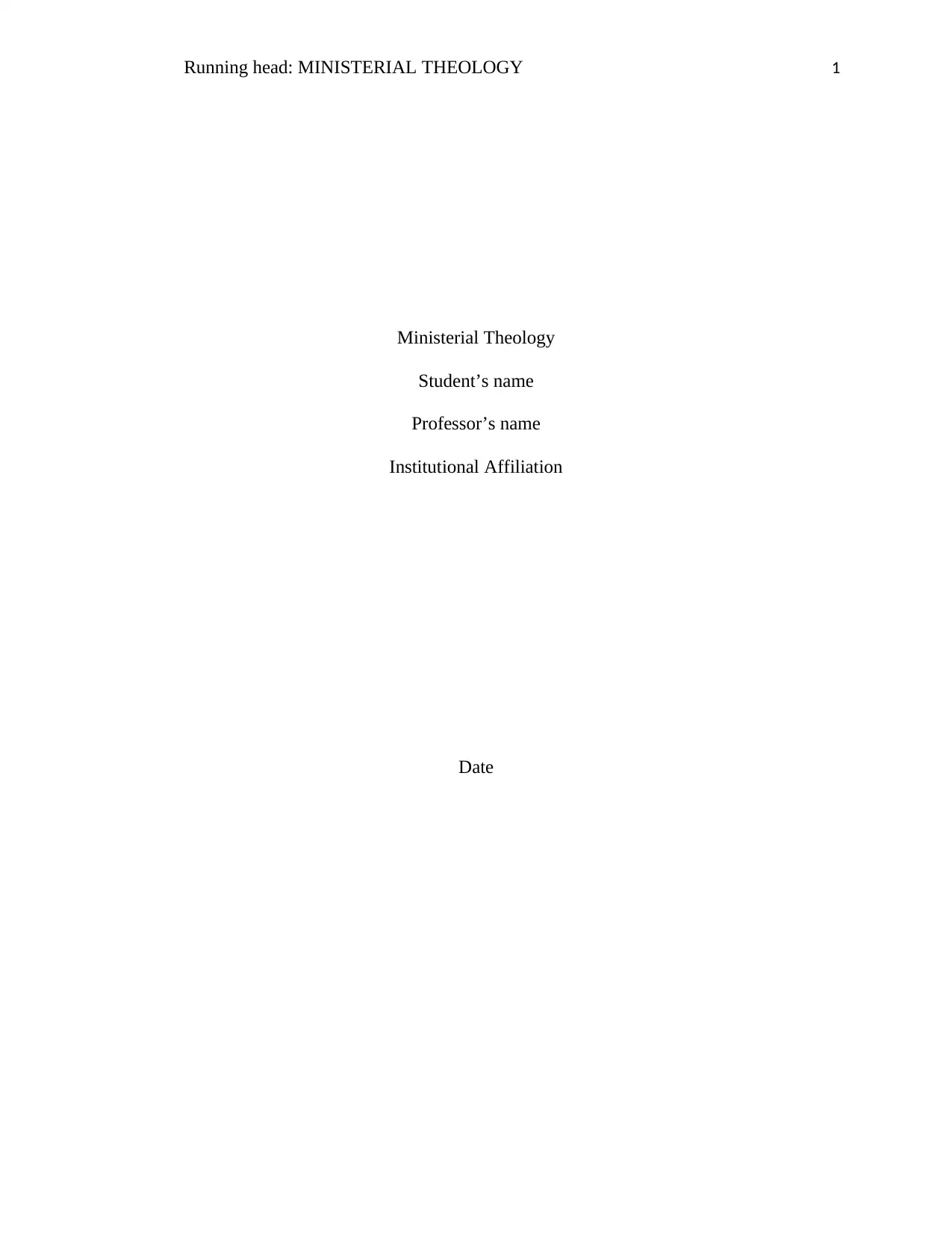
Running head: MINISTERIAL THEOLOGY 1
Ministerial Theology
Student’s name
Professor’s name
Institutional Affiliation
Date
Ministerial Theology
Student’s name
Professor’s name
Institutional Affiliation
Date
Secure Best Marks with AI Grader
Need help grading? Try our AI Grader for instant feedback on your assignments.
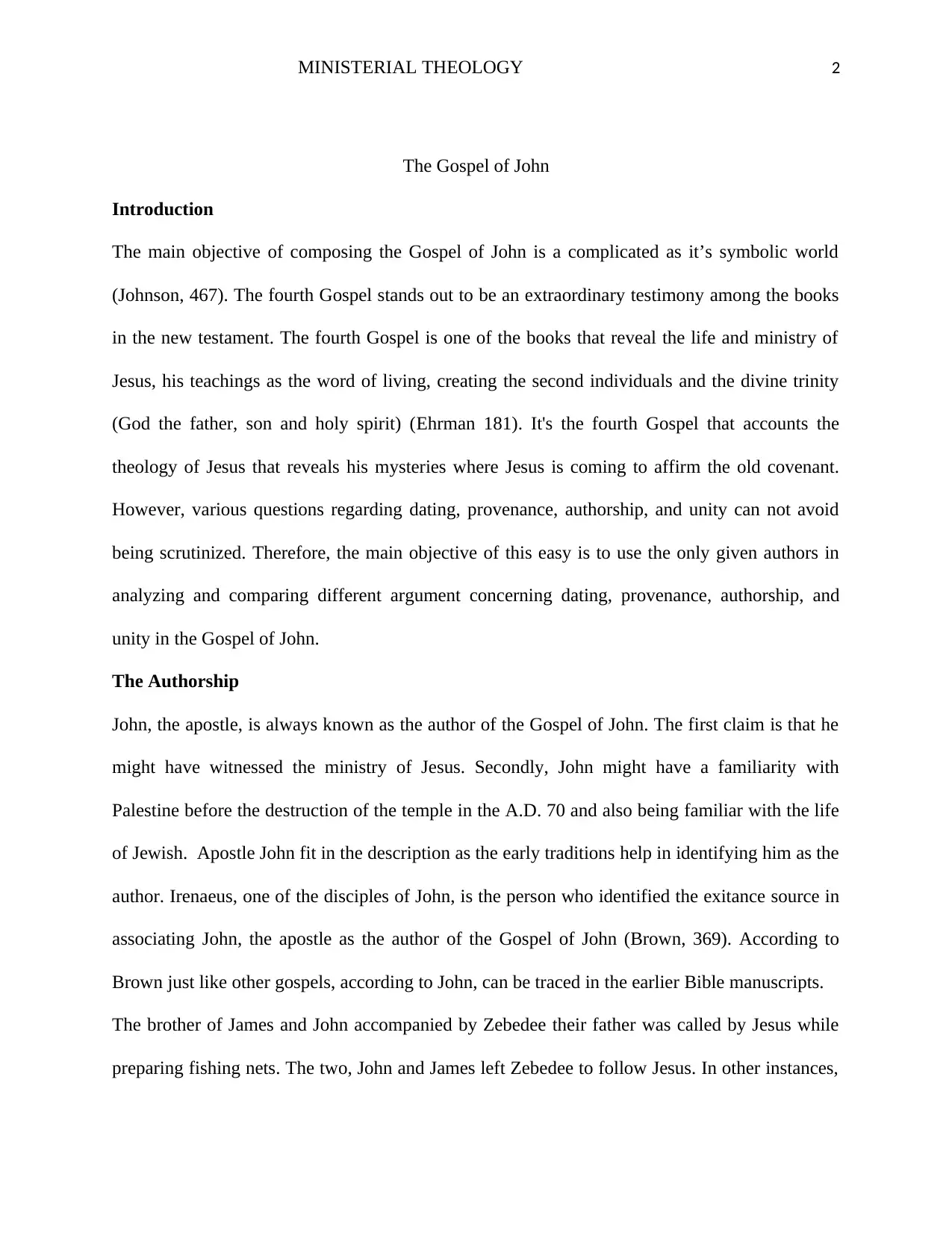
MINISTERIAL THEOLOGY 2
The Gospel of John
Introduction
The main objective of composing the Gospel of John is a complicated as it’s symbolic world
(Johnson, 467). The fourth Gospel stands out to be an extraordinary testimony among the books
in the new testament. The fourth Gospel is one of the books that reveal the life and ministry of
Jesus, his teachings as the word of living, creating the second individuals and the divine trinity
(God the father, son and holy spirit) (Ehrman 181). It's the fourth Gospel that accounts the
theology of Jesus that reveals his mysteries where Jesus is coming to affirm the old covenant.
However, various questions regarding dating, provenance, authorship, and unity can not avoid
being scrutinized. Therefore, the main objective of this easy is to use the only given authors in
analyzing and comparing different argument concerning dating, provenance, authorship, and
unity in the Gospel of John.
The Authorship
John, the apostle, is always known as the author of the Gospel of John. The first claim is that he
might have witnessed the ministry of Jesus. Secondly, John might have a familiarity with
Palestine before the destruction of the temple in the A.D. 70 and also being familiar with the life
of Jewish. Apostle John fit in the description as the early traditions help in identifying him as the
author. Irenaeus, one of the disciples of John, is the person who identified the exitance source in
associating John, the apostle as the author of the Gospel of John (Brown, 369). According to
Brown just like other gospels, according to John, can be traced in the earlier Bible manuscripts.
The brother of James and John accompanied by Zebedee their father was called by Jesus while
preparing fishing nets. The two, John and James left Zebedee to follow Jesus. In other instances,
The Gospel of John
Introduction
The main objective of composing the Gospel of John is a complicated as it’s symbolic world
(Johnson, 467). The fourth Gospel stands out to be an extraordinary testimony among the books
in the new testament. The fourth Gospel is one of the books that reveal the life and ministry of
Jesus, his teachings as the word of living, creating the second individuals and the divine trinity
(God the father, son and holy spirit) (Ehrman 181). It's the fourth Gospel that accounts the
theology of Jesus that reveals his mysteries where Jesus is coming to affirm the old covenant.
However, various questions regarding dating, provenance, authorship, and unity can not avoid
being scrutinized. Therefore, the main objective of this easy is to use the only given authors in
analyzing and comparing different argument concerning dating, provenance, authorship, and
unity in the Gospel of John.
The Authorship
John, the apostle, is always known as the author of the Gospel of John. The first claim is that he
might have witnessed the ministry of Jesus. Secondly, John might have a familiarity with
Palestine before the destruction of the temple in the A.D. 70 and also being familiar with the life
of Jewish. Apostle John fit in the description as the early traditions help in identifying him as the
author. Irenaeus, one of the disciples of John, is the person who identified the exitance source in
associating John, the apostle as the author of the Gospel of John (Brown, 369). According to
Brown just like other gospels, according to John, can be traced in the earlier Bible manuscripts.
The brother of James and John accompanied by Zebedee their father was called by Jesus while
preparing fishing nets. The two, John and James left Zebedee to follow Jesus. In other instances,
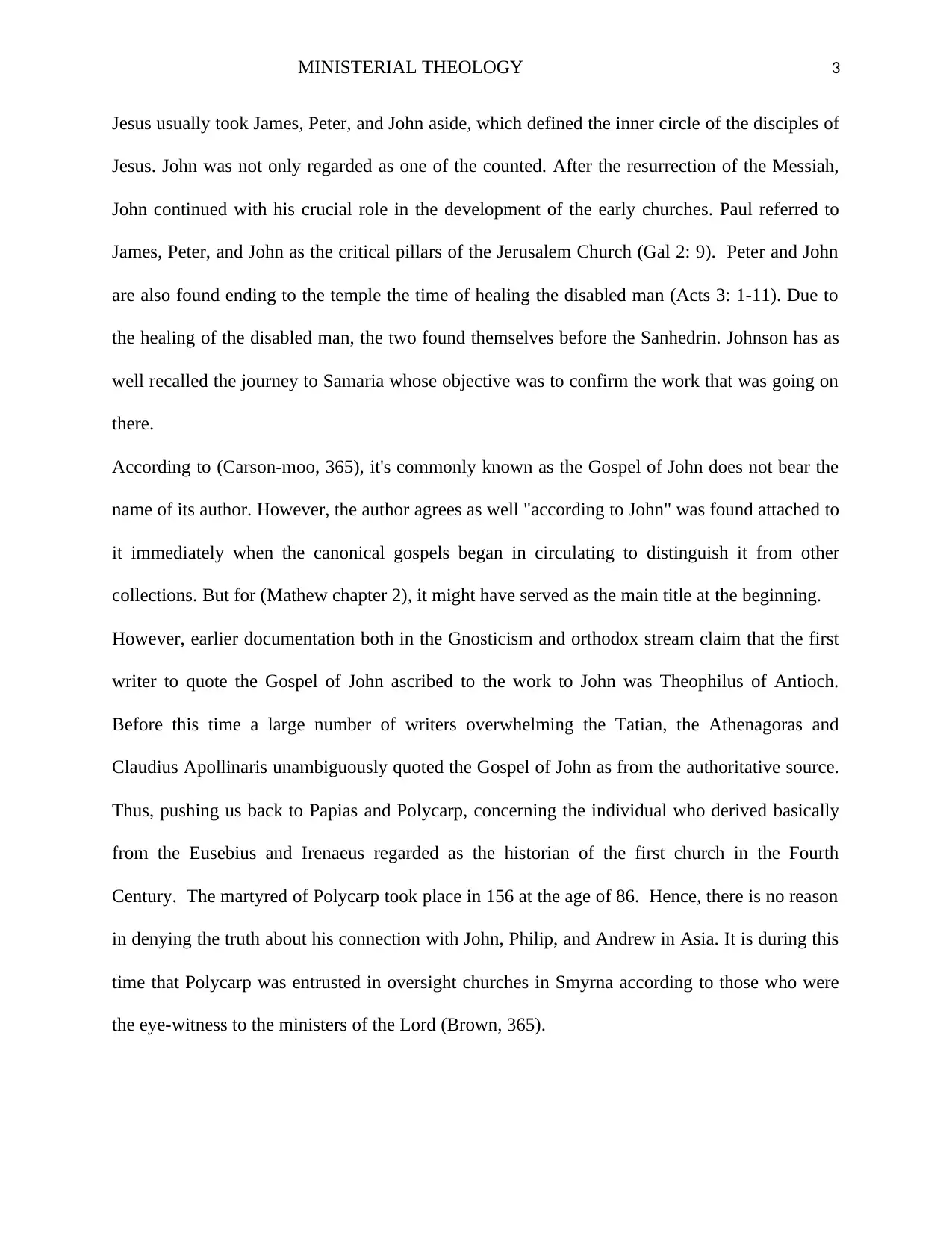
MINISTERIAL THEOLOGY 3
Jesus usually took James, Peter, and John aside, which defined the inner circle of the disciples of
Jesus. John was not only regarded as one of the counted. After the resurrection of the Messiah,
John continued with his crucial role in the development of the early churches. Paul referred to
James, Peter, and John as the critical pillars of the Jerusalem Church (Gal 2: 9). Peter and John
are also found ending to the temple the time of healing the disabled man (Acts 3: 1-11). Due to
the healing of the disabled man, the two found themselves before the Sanhedrin. Johnson has as
well recalled the journey to Samaria whose objective was to confirm the work that was going on
there.
According to (Carson-moo, 365), it's commonly known as the Gospel of John does not bear the
name of its author. However, the author agrees as well "according to John" was found attached to
it immediately when the canonical gospels began in circulating to distinguish it from other
collections. But for (Mathew chapter 2), it might have served as the main title at the beginning.
However, earlier documentation both in the Gnosticism and orthodox stream claim that the first
writer to quote the Gospel of John ascribed to the work to John was Theophilus of Antioch.
Before this time a large number of writers overwhelming the Tatian, the Athenagoras and
Claudius Apollinaris unambiguously quoted the Gospel of John as from the authoritative source.
Thus, pushing us back to Papias and Polycarp, concerning the individual who derived basically
from the Eusebius and Irenaeus regarded as the historian of the first church in the Fourth
Century. The martyred of Polycarp took place in 156 at the age of 86. Hence, there is no reason
in denying the truth about his connection with John, Philip, and Andrew in Asia. It is during this
time that Polycarp was entrusted in oversight churches in Smyrna according to those who were
the eye-witness to the ministers of the Lord (Brown, 365).
Jesus usually took James, Peter, and John aside, which defined the inner circle of the disciples of
Jesus. John was not only regarded as one of the counted. After the resurrection of the Messiah,
John continued with his crucial role in the development of the early churches. Paul referred to
James, Peter, and John as the critical pillars of the Jerusalem Church (Gal 2: 9). Peter and John
are also found ending to the temple the time of healing the disabled man (Acts 3: 1-11). Due to
the healing of the disabled man, the two found themselves before the Sanhedrin. Johnson has as
well recalled the journey to Samaria whose objective was to confirm the work that was going on
there.
According to (Carson-moo, 365), it's commonly known as the Gospel of John does not bear the
name of its author. However, the author agrees as well "according to John" was found attached to
it immediately when the canonical gospels began in circulating to distinguish it from other
collections. But for (Mathew chapter 2), it might have served as the main title at the beginning.
However, earlier documentation both in the Gnosticism and orthodox stream claim that the first
writer to quote the Gospel of John ascribed to the work to John was Theophilus of Antioch.
Before this time a large number of writers overwhelming the Tatian, the Athenagoras and
Claudius Apollinaris unambiguously quoted the Gospel of John as from the authoritative source.
Thus, pushing us back to Papias and Polycarp, concerning the individual who derived basically
from the Eusebius and Irenaeus regarded as the historian of the first church in the Fourth
Century. The martyred of Polycarp took place in 156 at the age of 86. Hence, there is no reason
in denying the truth about his connection with John, Philip, and Andrew in Asia. It is during this
time that Polycarp was entrusted in oversight churches in Smyrna according to those who were
the eye-witness to the ministers of the Lord (Brown, 365).
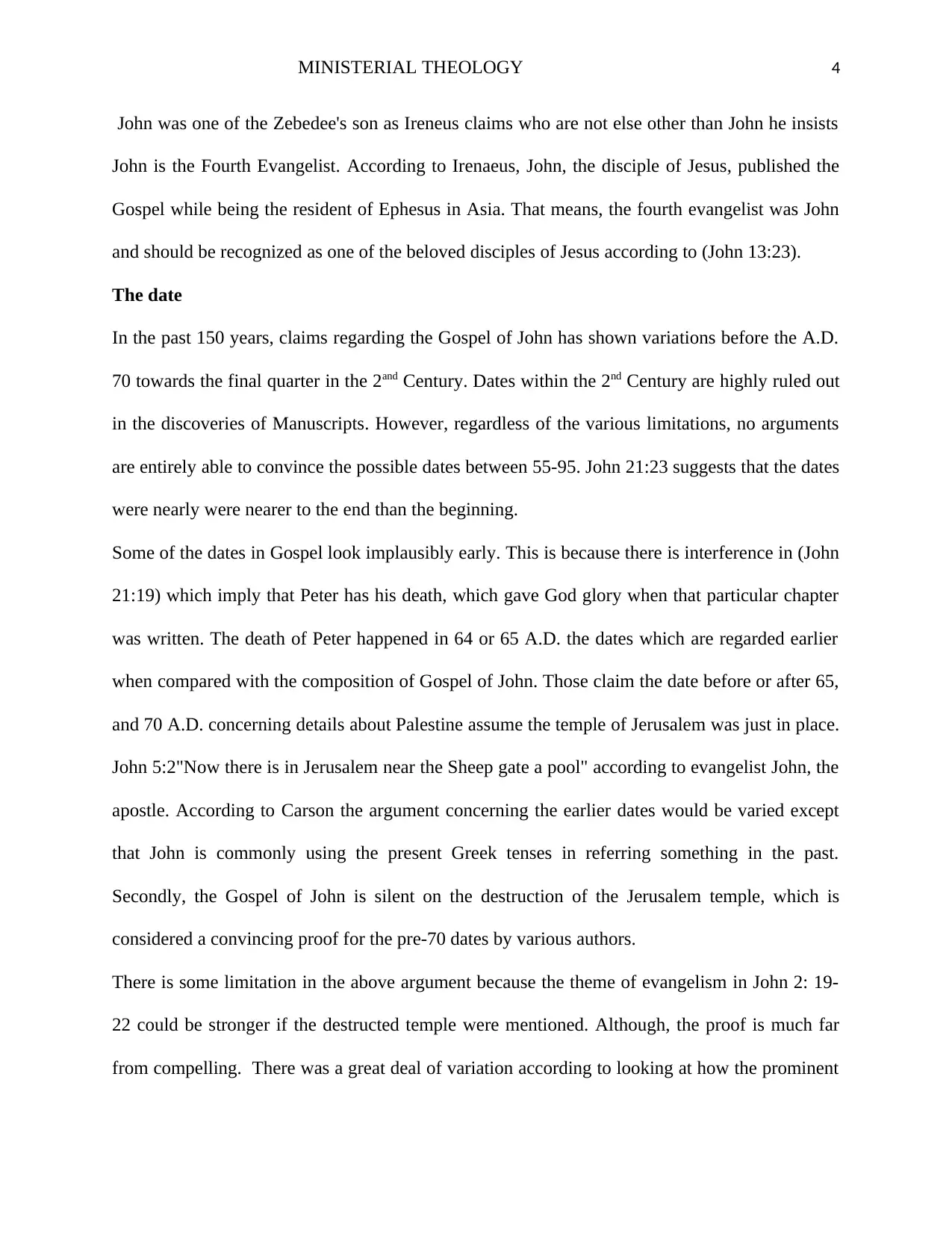
MINISTERIAL THEOLOGY 4
John was one of the Zebedee's son as Ireneus claims who are not else other than John he insists
John is the Fourth Evangelist. According to Irenaeus, John, the disciple of Jesus, published the
Gospel while being the resident of Ephesus in Asia. That means, the fourth evangelist was John
and should be recognized as one of the beloved disciples of Jesus according to (John 13:23).
The date
In the past 150 years, claims regarding the Gospel of John has shown variations before the A.D.
70 towards the final quarter in the 2and Century. Dates within the 2nd Century are highly ruled out
in the discoveries of Manuscripts. However, regardless of the various limitations, no arguments
are entirely able to convince the possible dates between 55-95. John 21:23 suggests that the dates
were nearly were nearer to the end than the beginning.
Some of the dates in Gospel look implausibly early. This is because there is interference in (John
21:19) which imply that Peter has his death, which gave God glory when that particular chapter
was written. The death of Peter happened in 64 or 65 A.D. the dates which are regarded earlier
when compared with the composition of Gospel of John. Those claim the date before or after 65,
and 70 A.D. concerning details about Palestine assume the temple of Jerusalem was just in place.
John 5:2"Now there is in Jerusalem near the Sheep gate a pool" according to evangelist John, the
apostle. According to Carson the argument concerning the earlier dates would be varied except
that John is commonly using the present Greek tenses in referring something in the past.
Secondly, the Gospel of John is silent on the destruction of the Jerusalem temple, which is
considered a convincing proof for the pre-70 dates by various authors.
There is some limitation in the above argument because the theme of evangelism in John 2: 19-
22 could be stronger if the destructed temple were mentioned. Although, the proof is much far
from compelling. There was a great deal of variation according to looking at how the prominent
John was one of the Zebedee's son as Ireneus claims who are not else other than John he insists
John is the Fourth Evangelist. According to Irenaeus, John, the disciple of Jesus, published the
Gospel while being the resident of Ephesus in Asia. That means, the fourth evangelist was John
and should be recognized as one of the beloved disciples of Jesus according to (John 13:23).
The date
In the past 150 years, claims regarding the Gospel of John has shown variations before the A.D.
70 towards the final quarter in the 2and Century. Dates within the 2nd Century are highly ruled out
in the discoveries of Manuscripts. However, regardless of the various limitations, no arguments
are entirely able to convince the possible dates between 55-95. John 21:23 suggests that the dates
were nearly were nearer to the end than the beginning.
Some of the dates in Gospel look implausibly early. This is because there is interference in (John
21:19) which imply that Peter has his death, which gave God glory when that particular chapter
was written. The death of Peter happened in 64 or 65 A.D. the dates which are regarded earlier
when compared with the composition of Gospel of John. Those claim the date before or after 65,
and 70 A.D. concerning details about Palestine assume the temple of Jerusalem was just in place.
John 5:2"Now there is in Jerusalem near the Sheep gate a pool" according to evangelist John, the
apostle. According to Carson the argument concerning the earlier dates would be varied except
that John is commonly using the present Greek tenses in referring something in the past.
Secondly, the Gospel of John is silent on the destruction of the Jerusalem temple, which is
considered a convincing proof for the pre-70 dates by various authors.
There is some limitation in the above argument because the theme of evangelism in John 2: 19-
22 could be stronger if the destructed temple were mentioned. Although, the proof is much far
from compelling. There was a great deal of variation according to looking at how the prominent
Secure Best Marks with AI Grader
Need help grading? Try our AI Grader for instant feedback on your assignments.
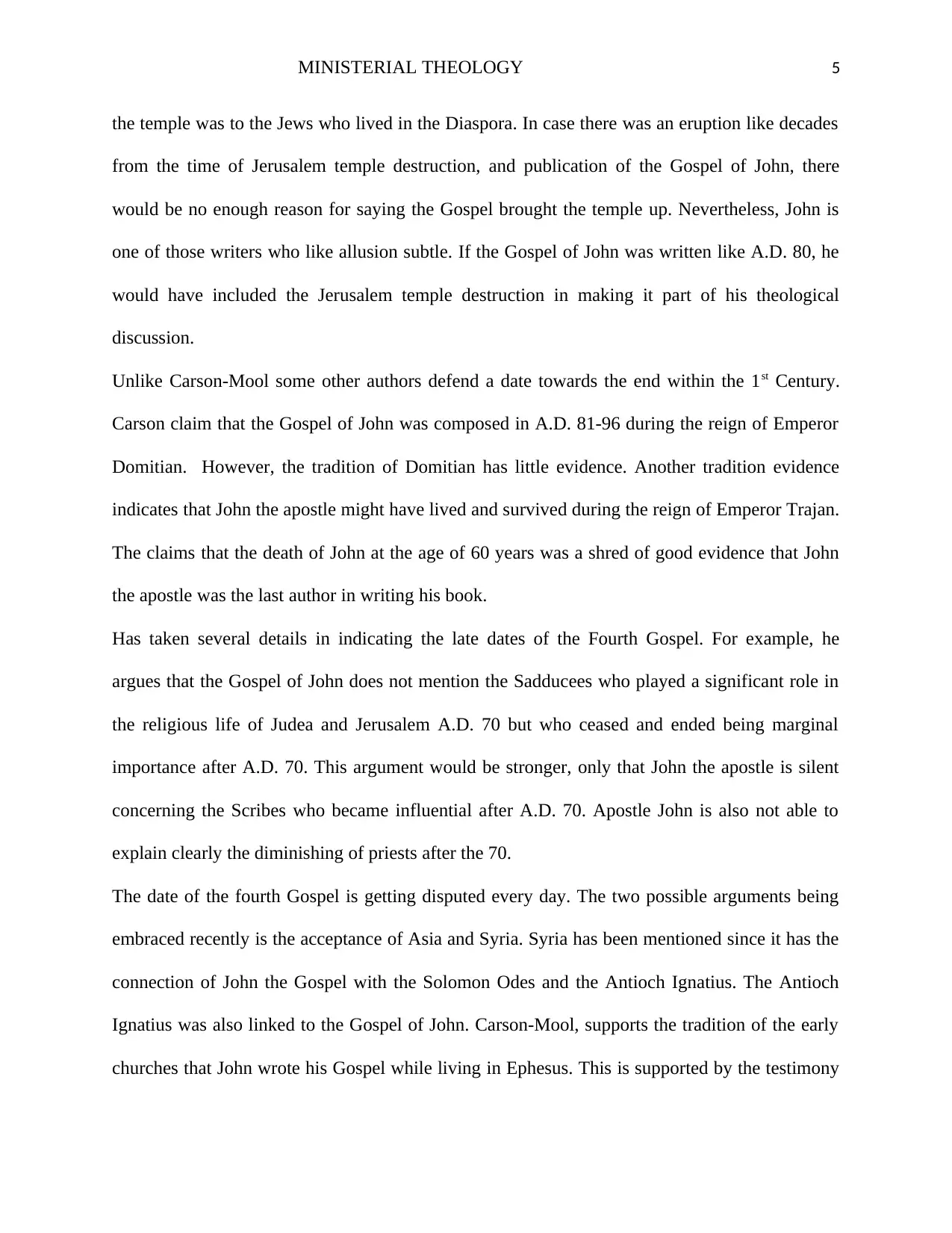
MINISTERIAL THEOLOGY 5
the temple was to the Jews who lived in the Diaspora. In case there was an eruption like decades
from the time of Jerusalem temple destruction, and publication of the Gospel of John, there
would be no enough reason for saying the Gospel brought the temple up. Nevertheless, John is
one of those writers who like allusion subtle. If the Gospel of John was written like A.D. 80, he
would have included the Jerusalem temple destruction in making it part of his theological
discussion.
Unlike Carson-Mool some other authors defend a date towards the end within the 1st Century.
Carson claim that the Gospel of John was composed in A.D. 81-96 during the reign of Emperor
Domitian. However, the tradition of Domitian has little evidence. Another tradition evidence
indicates that John the apostle might have lived and survived during the reign of Emperor Trajan.
The claims that the death of John at the age of 60 years was a shred of good evidence that John
the apostle was the last author in writing his book.
Has taken several details in indicating the late dates of the Fourth Gospel. For example, he
argues that the Gospel of John does not mention the Sadducees who played a significant role in
the religious life of Judea and Jerusalem A.D. 70 but who ceased and ended being marginal
importance after A.D. 70. This argument would be stronger, only that John the apostle is silent
concerning the Scribes who became influential after A.D. 70. Apostle John is also not able to
explain clearly the diminishing of priests after the 70.
The date of the fourth Gospel is getting disputed every day. The two possible arguments being
embraced recently is the acceptance of Asia and Syria. Syria has been mentioned since it has the
connection of John the Gospel with the Solomon Odes and the Antioch Ignatius. The Antioch
Ignatius was also linked to the Gospel of John. Carson-Mool, supports the tradition of the early
churches that John wrote his Gospel while living in Ephesus. This is supported by the testimony
the temple was to the Jews who lived in the Diaspora. In case there was an eruption like decades
from the time of Jerusalem temple destruction, and publication of the Gospel of John, there
would be no enough reason for saying the Gospel brought the temple up. Nevertheless, John is
one of those writers who like allusion subtle. If the Gospel of John was written like A.D. 80, he
would have included the Jerusalem temple destruction in making it part of his theological
discussion.
Unlike Carson-Mool some other authors defend a date towards the end within the 1st Century.
Carson claim that the Gospel of John was composed in A.D. 81-96 during the reign of Emperor
Domitian. However, the tradition of Domitian has little evidence. Another tradition evidence
indicates that John the apostle might have lived and survived during the reign of Emperor Trajan.
The claims that the death of John at the age of 60 years was a shred of good evidence that John
the apostle was the last author in writing his book.
Has taken several details in indicating the late dates of the Fourth Gospel. For example, he
argues that the Gospel of John does not mention the Sadducees who played a significant role in
the religious life of Judea and Jerusalem A.D. 70 but who ceased and ended being marginal
importance after A.D. 70. This argument would be stronger, only that John the apostle is silent
concerning the Scribes who became influential after A.D. 70. Apostle John is also not able to
explain clearly the diminishing of priests after the 70.
The date of the fourth Gospel is getting disputed every day. The two possible arguments being
embraced recently is the acceptance of Asia and Syria. Syria has been mentioned since it has the
connection of John the Gospel with the Solomon Odes and the Antioch Ignatius. The Antioch
Ignatius was also linked to the Gospel of John. Carson-Mool, supports the tradition of the early
churches that John wrote his Gospel while living in Ephesus. This is supported by the testimony
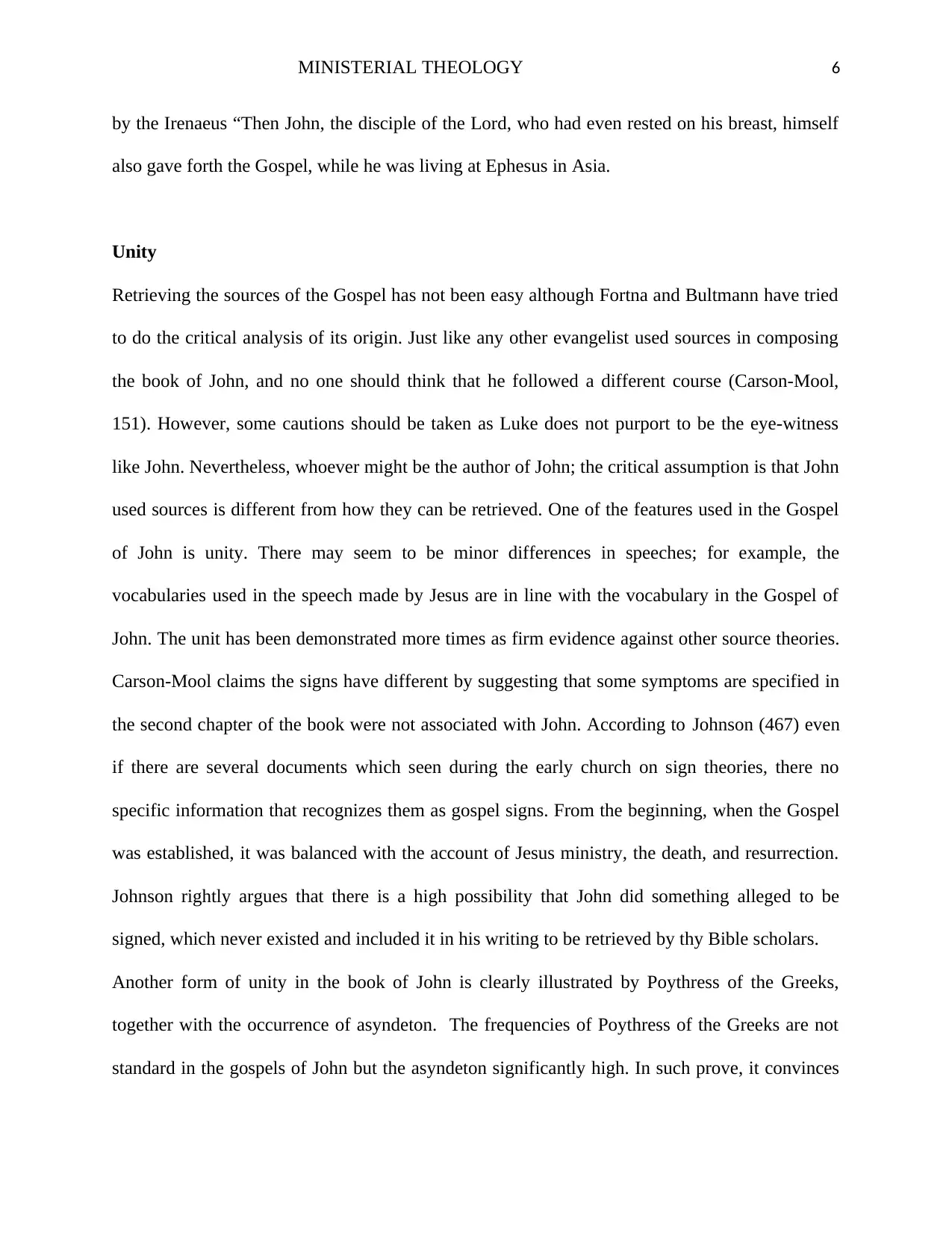
MINISTERIAL THEOLOGY 6
by the Irenaeus “Then John, the disciple of the Lord, who had even rested on his breast, himself
also gave forth the Gospel, while he was living at Ephesus in Asia.
Unity
Retrieving the sources of the Gospel has not been easy although Fortna and Bultmann have tried
to do the critical analysis of its origin. Just like any other evangelist used sources in composing
the book of John, and no one should think that he followed a different course (Carson-Mool,
151). However, some cautions should be taken as Luke does not purport to be the eye-witness
like John. Nevertheless, whoever might be the author of John; the critical assumption is that John
used sources is different from how they can be retrieved. One of the features used in the Gospel
of John is unity. There may seem to be minor differences in speeches; for example, the
vocabularies used in the speech made by Jesus are in line with the vocabulary in the Gospel of
John. The unit has been demonstrated more times as firm evidence against other source theories.
Carson-Mool claims the signs have different by suggesting that some symptoms are specified in
the second chapter of the book were not associated with John. According to Johnson (467) even
if there are several documents which seen during the early church on sign theories, there no
specific information that recognizes them as gospel signs. From the beginning, when the Gospel
was established, it was balanced with the account of Jesus ministry, the death, and resurrection.
Johnson rightly argues that there is a high possibility that John did something alleged to be
signed, which never existed and included it in his writing to be retrieved by thy Bible scholars.
Another form of unity in the book of John is clearly illustrated by Poythress of the Greeks,
together with the occurrence of asyndeton. The frequencies of Poythress of the Greeks are not
standard in the gospels of John but the asyndeton significantly high. In such prove, it convinces
by the Irenaeus “Then John, the disciple of the Lord, who had even rested on his breast, himself
also gave forth the Gospel, while he was living at Ephesus in Asia.
Unity
Retrieving the sources of the Gospel has not been easy although Fortna and Bultmann have tried
to do the critical analysis of its origin. Just like any other evangelist used sources in composing
the book of John, and no one should think that he followed a different course (Carson-Mool,
151). However, some cautions should be taken as Luke does not purport to be the eye-witness
like John. Nevertheless, whoever might be the author of John; the critical assumption is that John
used sources is different from how they can be retrieved. One of the features used in the Gospel
of John is unity. There may seem to be minor differences in speeches; for example, the
vocabularies used in the speech made by Jesus are in line with the vocabulary in the Gospel of
John. The unit has been demonstrated more times as firm evidence against other source theories.
Carson-Mool claims the signs have different by suggesting that some symptoms are specified in
the second chapter of the book were not associated with John. According to Johnson (467) even
if there are several documents which seen during the early church on sign theories, there no
specific information that recognizes them as gospel signs. From the beginning, when the Gospel
was established, it was balanced with the account of Jesus ministry, the death, and resurrection.
Johnson rightly argues that there is a high possibility that John did something alleged to be
signed, which never existed and included it in his writing to be retrieved by thy Bible scholars.
Another form of unity in the book of John is clearly illustrated by Poythress of the Greeks,
together with the occurrence of asyndeton. The frequencies of Poythress of the Greeks are not
standard in the gospels of John but the asyndeton significantly high. In such prove, it convinces
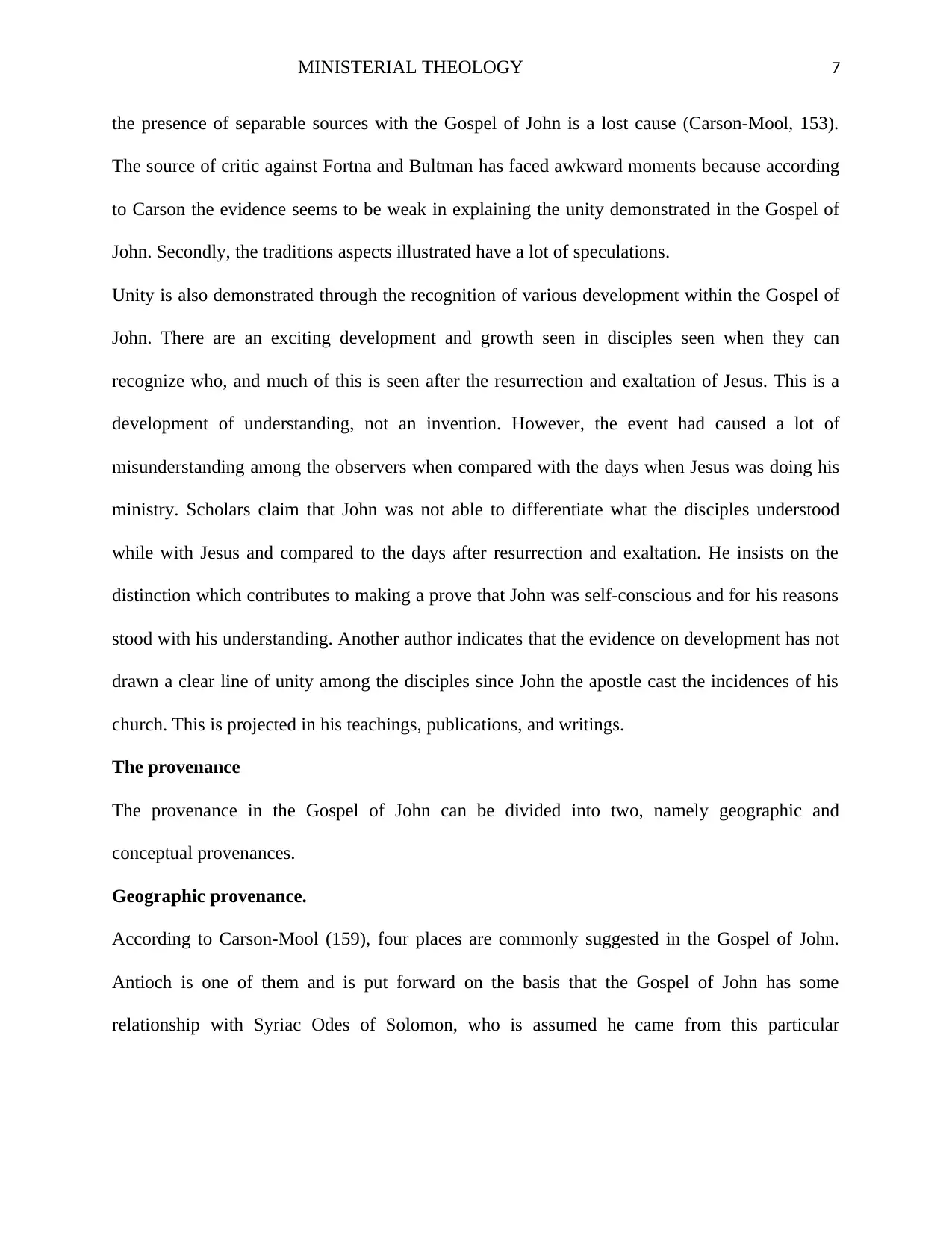
MINISTERIAL THEOLOGY 7
the presence of separable sources with the Gospel of John is a lost cause (Carson-Mool, 153).
The source of critic against Fortna and Bultman has faced awkward moments because according
to Carson the evidence seems to be weak in explaining the unity demonstrated in the Gospel of
John. Secondly, the traditions aspects illustrated have a lot of speculations.
Unity is also demonstrated through the recognition of various development within the Gospel of
John. There are an exciting development and growth seen in disciples seen when they can
recognize who, and much of this is seen after the resurrection and exaltation of Jesus. This is a
development of understanding, not an invention. However, the event had caused a lot of
misunderstanding among the observers when compared with the days when Jesus was doing his
ministry. Scholars claim that John was not able to differentiate what the disciples understood
while with Jesus and compared to the days after resurrection and exaltation. He insists on the
distinction which contributes to making a prove that John was self-conscious and for his reasons
stood with his understanding. Another author indicates that the evidence on development has not
drawn a clear line of unity among the disciples since John the apostle cast the incidences of his
church. This is projected in his teachings, publications, and writings.
The provenance
The provenance in the Gospel of John can be divided into two, namely geographic and
conceptual provenances.
Geographic provenance.
According to Carson-Mool (159), four places are commonly suggested in the Gospel of John.
Antioch is one of them and is put forward on the basis that the Gospel of John has some
relationship with Syriac Odes of Solomon, who is assumed he came from this particular
the presence of separable sources with the Gospel of John is a lost cause (Carson-Mool, 153).
The source of critic against Fortna and Bultman has faced awkward moments because according
to Carson the evidence seems to be weak in explaining the unity demonstrated in the Gospel of
John. Secondly, the traditions aspects illustrated have a lot of speculations.
Unity is also demonstrated through the recognition of various development within the Gospel of
John. There are an exciting development and growth seen in disciples seen when they can
recognize who, and much of this is seen after the resurrection and exaltation of Jesus. This is a
development of understanding, not an invention. However, the event had caused a lot of
misunderstanding among the observers when compared with the days when Jesus was doing his
ministry. Scholars claim that John was not able to differentiate what the disciples understood
while with Jesus and compared to the days after resurrection and exaltation. He insists on the
distinction which contributes to making a prove that John was self-conscious and for his reasons
stood with his understanding. Another author indicates that the evidence on development has not
drawn a clear line of unity among the disciples since John the apostle cast the incidences of his
church. This is projected in his teachings, publications, and writings.
The provenance
The provenance in the Gospel of John can be divided into two, namely geographic and
conceptual provenances.
Geographic provenance.
According to Carson-Mool (159), four places are commonly suggested in the Gospel of John.
Antioch is one of them and is put forward on the basis that the Gospel of John has some
relationship with Syriac Odes of Solomon, who is assumed he came from this particular
Paraphrase This Document
Need a fresh take? Get an instant paraphrase of this document with our AI Paraphraser
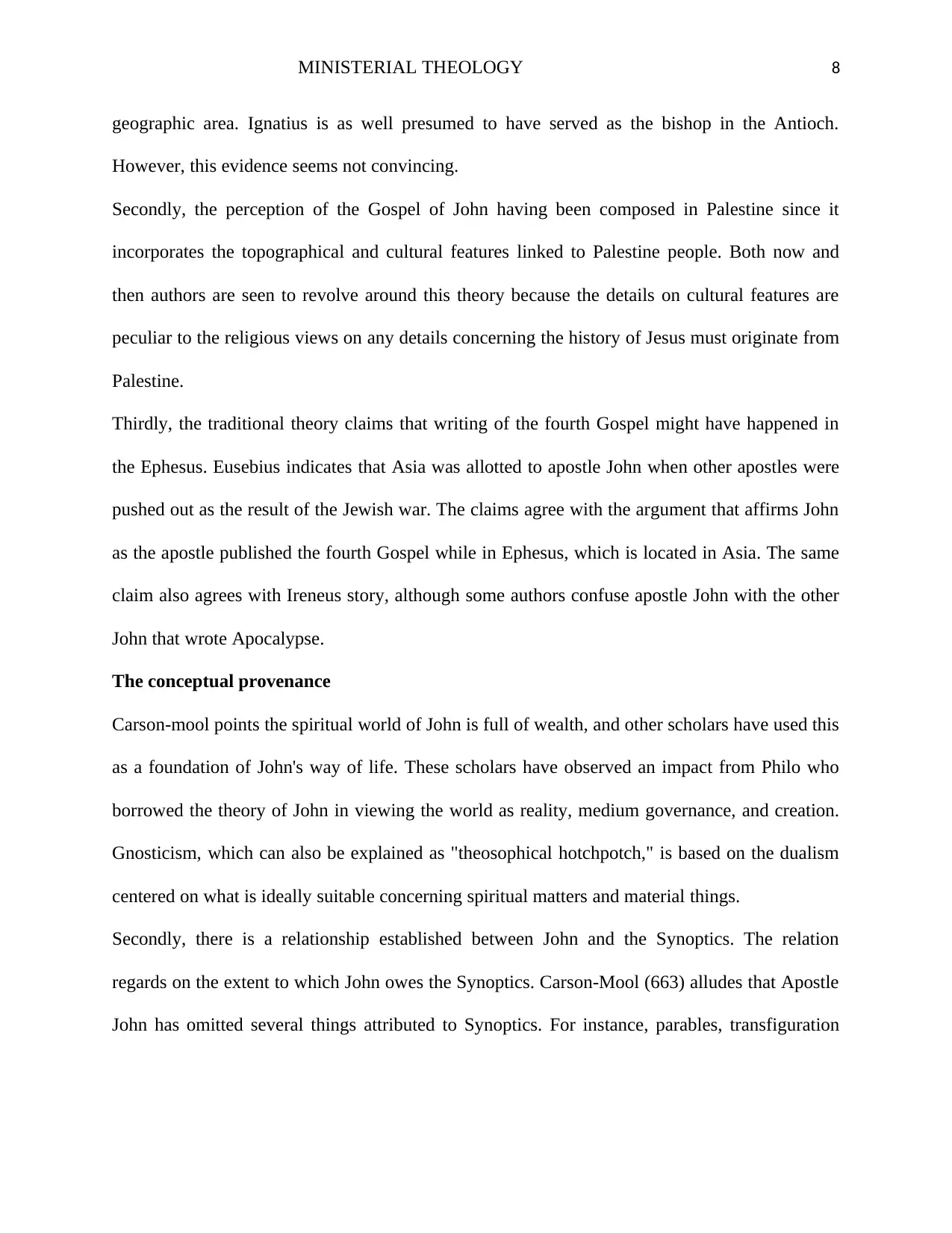
MINISTERIAL THEOLOGY 8
geographic area. Ignatius is as well presumed to have served as the bishop in the Antioch.
However, this evidence seems not convincing.
Secondly, the perception of the Gospel of John having been composed in Palestine since it
incorporates the topographical and cultural features linked to Palestine people. Both now and
then authors are seen to revolve around this theory because the details on cultural features are
peculiar to the religious views on any details concerning the history of Jesus must originate from
Palestine.
Thirdly, the traditional theory claims that writing of the fourth Gospel might have happened in
the Ephesus. Eusebius indicates that Asia was allotted to apostle John when other apostles were
pushed out as the result of the Jewish war. The claims agree with the argument that affirms John
as the apostle published the fourth Gospel while in Ephesus, which is located in Asia. The same
claim also agrees with Ireneus story, although some authors confuse apostle John with the other
John that wrote Apocalypse.
The conceptual provenance
Carson-mool points the spiritual world of John is full of wealth, and other scholars have used this
as a foundation of John's way of life. These scholars have observed an impact from Philo who
borrowed the theory of John in viewing the world as reality, medium governance, and creation.
Gnosticism, which can also be explained as "theosophical hotchpotch," is based on the dualism
centered on what is ideally suitable concerning spiritual matters and material things.
Secondly, there is a relationship established between John and the Synoptics. The relation
regards on the extent to which John owes the Synoptics. Carson-Mool (663) alludes that Apostle
John has omitted several things attributed to Synoptics. For instance, parables, transfiguration
geographic area. Ignatius is as well presumed to have served as the bishop in the Antioch.
However, this evidence seems not convincing.
Secondly, the perception of the Gospel of John having been composed in Palestine since it
incorporates the topographical and cultural features linked to Palestine people. Both now and
then authors are seen to revolve around this theory because the details on cultural features are
peculiar to the religious views on any details concerning the history of Jesus must originate from
Palestine.
Thirdly, the traditional theory claims that writing of the fourth Gospel might have happened in
the Ephesus. Eusebius indicates that Asia was allotted to apostle John when other apostles were
pushed out as the result of the Jewish war. The claims agree with the argument that affirms John
as the apostle published the fourth Gospel while in Ephesus, which is located in Asia. The same
claim also agrees with Ireneus story, although some authors confuse apostle John with the other
John that wrote Apocalypse.
The conceptual provenance
Carson-mool points the spiritual world of John is full of wealth, and other scholars have used this
as a foundation of John's way of life. These scholars have observed an impact from Philo who
borrowed the theory of John in viewing the world as reality, medium governance, and creation.
Gnosticism, which can also be explained as "theosophical hotchpotch," is based on the dualism
centered on what is ideally suitable concerning spiritual matters and material things.
Secondly, there is a relationship established between John and the Synoptics. The relation
regards on the extent to which John owes the Synoptics. Carson-Mool (663) alludes that Apostle
John has omitted several things attributed to Synoptics. For instance, parables, transfiguration
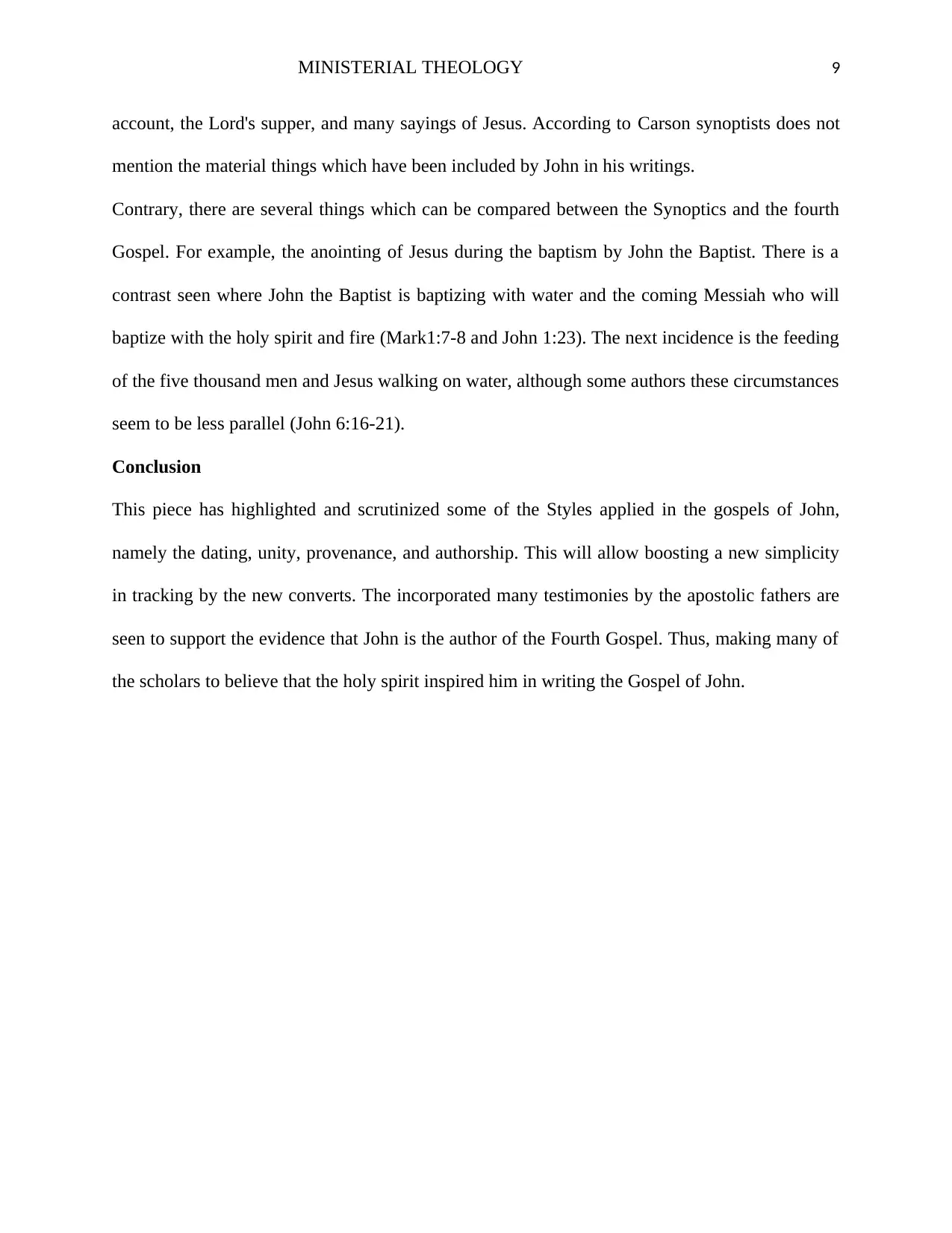
MINISTERIAL THEOLOGY 9
account, the Lord's supper, and many sayings of Jesus. According to Carson synoptists does not
mention the material things which have been included by John in his writings.
Contrary, there are several things which can be compared between the Synoptics and the fourth
Gospel. For example, the anointing of Jesus during the baptism by John the Baptist. There is a
contrast seen where John the Baptist is baptizing with water and the coming Messiah who will
baptize with the holy spirit and fire (Mark1:7-8 and John 1:23). The next incidence is the feeding
of the five thousand men and Jesus walking on water, although some authors these circumstances
seem to be less parallel (John 6:16-21).
Conclusion
This piece has highlighted and scrutinized some of the Styles applied in the gospels of John,
namely the dating, unity, provenance, and authorship. This will allow boosting a new simplicity
in tracking by the new converts. The incorporated many testimonies by the apostolic fathers are
seen to support the evidence that John is the author of the Fourth Gospel. Thus, making many of
the scholars to believe that the holy spirit inspired him in writing the Gospel of John.
account, the Lord's supper, and many sayings of Jesus. According to Carson synoptists does not
mention the material things which have been included by John in his writings.
Contrary, there are several things which can be compared between the Synoptics and the fourth
Gospel. For example, the anointing of Jesus during the baptism by John the Baptist. There is a
contrast seen where John the Baptist is baptizing with water and the coming Messiah who will
baptize with the holy spirit and fire (Mark1:7-8 and John 1:23). The next incidence is the feeding
of the five thousand men and Jesus walking on water, although some authors these circumstances
seem to be less parallel (John 6:16-21).
Conclusion
This piece has highlighted and scrutinized some of the Styles applied in the gospels of John,
namely the dating, unity, provenance, and authorship. This will allow boosting a new simplicity
in tracking by the new converts. The incorporated many testimonies by the apostolic fathers are
seen to support the evidence that John is the author of the Fourth Gospel. Thus, making many of
the scholars to believe that the holy spirit inspired him in writing the Gospel of John.
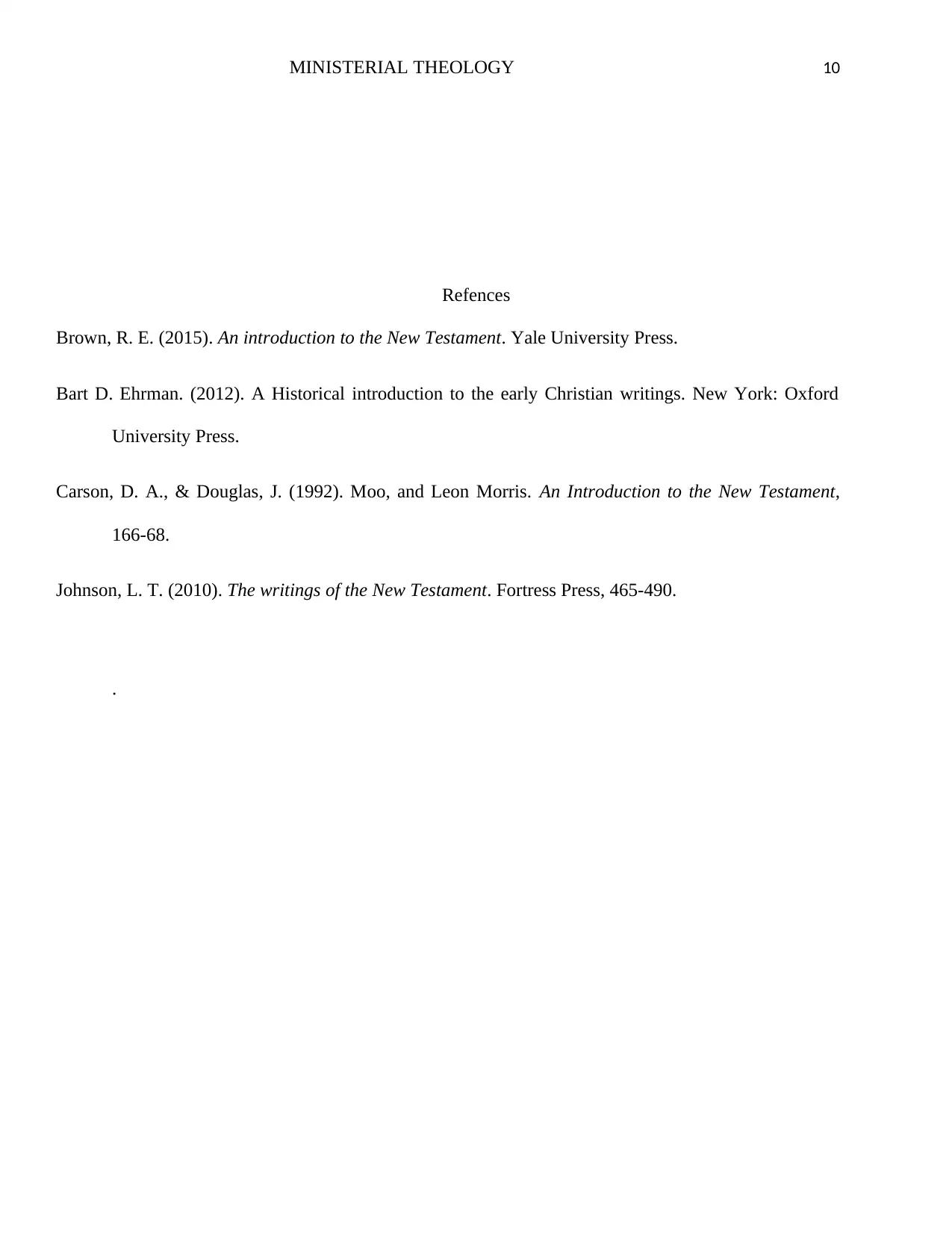
MINISTERIAL THEOLOGY 10
Refences
Brown, R. E. (2015). An introduction to the New Testament. Yale University Press.
Bart D. Ehrman. (2012). A Historical introduction to the early Christian writings. New York: Oxford
University Press.
Carson, D. A., & Douglas, J. (1992). Moo, and Leon Morris. An Introduction to the New Testament,
166-68.
Johnson, L. T. (2010). The writings of the New Testament. Fortress Press, 465-490.
.
Refences
Brown, R. E. (2015). An introduction to the New Testament. Yale University Press.
Bart D. Ehrman. (2012). A Historical introduction to the early Christian writings. New York: Oxford
University Press.
Carson, D. A., & Douglas, J. (1992). Moo, and Leon Morris. An Introduction to the New Testament,
166-68.
Johnson, L. T. (2010). The writings of the New Testament. Fortress Press, 465-490.
.
1 out of 10
Your All-in-One AI-Powered Toolkit for Academic Success.
+13062052269
info@desklib.com
Available 24*7 on WhatsApp / Email
![[object Object]](/_next/static/media/star-bottom.7253800d.svg)
Unlock your academic potential
© 2024 | Zucol Services PVT LTD | All rights reserved.